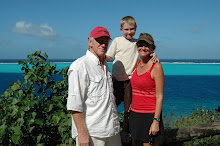The Pacific Ocean continues to amaze us in it's vastness and variety. Since leaving Puerto Vallarta on April 1, we have traveled 3938 nautical miles and we are just over 1/2 way to New Zealand. Oso Blanco has become so much more than our home as we have crossed great distances and visited wonderful islands.
The distances we have traveled and the extended periods of self suffiency away from nearly all services and conveniences magnify the quality, comfort and safety of our Nordhavn. At times, it is a wierd feeling to think that we are 1000s of miles from land with over 10,000' of water below us, and we are being powered by one diesel engine that just keeps humming along. It is one thing to make coastal ocean trips hopping from one port to the next. It is a very different thing to be far away from a fuel station, boat mechanic, and parts store for weeks and months at a time. A boat is often compared to a house, but it is really more like a floating city. In addition to our propulsion system, we have a sewage system, power plant to meet all of our electrical needs, water treatment plant to provide nearly unlimited fresh water from sea water, and 'transportation' system to be able to reach shore or explore. All of this is contained in a floating structure that must take what ever the sea throws at it.
There are many ways to cross oceans and most of our friends and the other folks out here are traveling in much simpler sailboats. The difference in mode of propulsion is obvious, but it is not the biggest difference. Most of the other boats have relatively small capacities for refridgeration, fuel, and producing fresh water. In recent weeks, as we have all spent increasing amounts of time away from it all, we have provided fresh water, fuel, and cold beer to those "in need". Most of the time, this is more of a luxury to a boat that has had few (or no) freshwater hot showers in a while, but in a couple cases, where their watermakers have had problems, we have been able to provide more than subsistence quantities. Many of the more remote islands have little or no fresh water to provide to traveling boats and you must stretch your water capacity as you would when backpacking or camping. It has become a common sight to see water jugs being hauled over to us and in two cases, we had other boats tie up along side us, passed them a hose, and filled their water tanks. To give an idea of scale, some of the smaller boats have a total freshwater storage capacity of less than 50 gallons. Our water makers can produce 60 gallons per HOUR!
A frequent criticism of a boat like ours is that the more systems (and conveniences) you have the more problems you have. The KISS (keep it simple stupid) approach to cruising has a lot to be said for it, however, if you only have basic systems, with no redundancy, when you do have a problem, you may have a big problem. Continuous 24 hr/day use for months at a time of all our systems has shown the quality of design and build of our little ship. We have had no issues or problems beyond normal maintenance and we are truely "at home" in the most remote anchorages.
Last Sunday night, with 27 people aboard for a slide presentation and dinner, we had a fleet of dinghys tied up behind Oso. Instead of a mother ship, perhaps we looked more like a 7 - Eleven of the Pacific.
E

